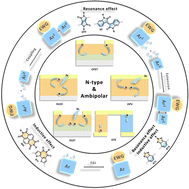Recent advances in n-type and ambipolar organic semiconductors and their multi-functional applications
Abstract
Organic semiconductors have received broad attention and research interest due to their unique integration of semiconducting properties with structural tunability, intrinsic flexibiltiy and low cost. In order to meet the requirements of organic electronic devices and their integrated circuits, p-type, n-type and ambipolar organic semiconductors are all necessary. However, due to the limitation in both material synthesis and device fabrication, the development of n-type and ambipolar materials is quite behind that of p-type materials. Recent development in synthetic methods of organic semiconductors greatly enriches the range of n-type and ambipolar materials. Moreover, the newly developed materials with multiple functions also put forward multi-functional device applications, including some emerging research areas. In this review, we give a timely summary on these impressive advances in n-type and ambipolar organic semiconductors with a special focus on their synthesis methods and advanced materials with enhanced properties of charge carrier mobility, integration of high mobility and strong emission and thermoelectric properties. Finally, multi-functional device applications are further demonstrated as an example of these developed n-type and ambipolar materials.



 Please wait while we load your content...
Please wait while we load your content...